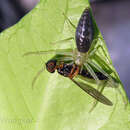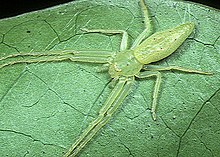en
names in breadcrumbs



The genus Oxytate, commonly known as grass crab spiders,[1] comprises a homogenous group of nocturnal crab spiders (family Thomisidae).[2] The complete mitochondrial genome of the type species O. striatipes was determined in 2014.[3]
Although they do not construct webs, both sexes possess a silk apparatus. A study of the type species, O. striatipes, revealed that they possess a simpler and more primitive spigot system than other members of the family, as even the females possess neither tubuliform glands for cocoon production, nor triad spigots for web-building. Males and females do however have three types of silk gland, which are classified as ampullate, pyriform and aciniform.[4]
Four ampullate glands are connected to the anterior spinnerets, while eight minor ampullate glands are connected to the median spinnerets. The pyriform glands are connected to the anterior spinnerets (90 in females and 80 in males). The aciniform glands are connected to the median (18–24 in females and 14–20 in males) and posterior spinnerets (60 in either sex).[4]
Green crab spiders are very helpful to honeybee and plants to interact. Oxytate has an ability to reflect UV lights which makes flowers more attractive to honeybees. And by attracting honeybees, it is captured in a trap of crab spiders.[5]
Like other crab spiders, they are masters of ambush and disguise.[1] They stalk their prey at night, from an ambush position on a grass stem or from the underside of a leaf. They can sense the vibrations caused by invertebrates moving on the leaf's upper side, and quickly pounce on the victim.[6] While in ambush on twigs or grass, the short hind legs hold onto the stem, while the long anterior legs are stretched forward.[1] Their bite is not harmful to humans, unless it would cause an allergic reaction.[7]
They are native to Asia, Western Australia, East, Central and southern Africa.[8]
As of November 2022 it contains 30 species:
 Female O. hoshizuna in Okinawa, Japan
Female O. hoshizuna in Okinawa, Japan  Female of the type species O. striatipes, on Hydrangea leaf, Japan
Female of the type species O. striatipes, on Hydrangea leaf, Japan The genus Oxytate, commonly known as grass crab spiders, comprises a homogenous group of nocturnal crab spiders (family Thomisidae). The complete mitochondrial genome of the type species O. striatipes was determined in 2014.
Oxytate es un género de arañas cangrejo de la familia Thomisidae.[1] Son especies nativas de Asia, Australia Occidental, África Oriental, Central y Meridional.
Al igual que otras arañas cangrejo, son maestras de las emboscadas.[2] Acechan a sus presas por la noche, desde una posición de emboscada en un tallo de hierba o desde la parte inferior de una hoja. Pueden sentir las vibraciones causadas por los invertebrados que se mueven en la parte superior de la hoja y rápidamente se abalanzan sobre la víctima. Mientras está en una emboscada sobre ramas o hierba, las patas traseras cortas se sujetan al tallo, mientras que las patas anteriores largas se estiran hacia adelante.[2] Su picadura no es dañina para los humanos, a menos que cause una reacción alérgica.[3]
Aunque no construyen telarañas, ambos sexos poseen una seda de araña. Un estudio de la especie tipo, Oxytate striatipes, reveló que poseen un sistema de espigas más simple y primitivo que otras arañas errantes, ya que incluso las hembras no poseen glándulas tubuliformes para la producción de capullos, ni espigas de tríadas para la construcción de telarañas. Sin embargo, los machos y las hembras tienen tres tipos de glándulas de seda, que se clasifican en ampolladas, piriformes y aciniformes.[4]
Cuatro glándulas ampolladas están conectadas a las hileras anteriores, mientras que ocho glándulas ampolladas menores están conectadas a las hileras medianas. Las glándulas piriformes están conectadas a las hileras anteriores (90 en hembras y 80 en machos). Las glándulas aciniformes están conectadas a la mediana (18 a 24 en mujeres y 14 a 20 en hombres) y a las hileras posteriores (60 en ambos sexos).[4]
Oxytate es un género de arañas cangrejo de la familia Thomisidae. Son especies nativas de Asia, Australia Occidental, África Oriental, Central y Meridional.
Oxytate est un genre d'araignées aranéomorphes de la famille des Thomisidae[1].
Les espèces de ce genre se rencontrent en Asie, en Afrique subsaharienne et en Australie[1].
Selon World Spider Catalog (version 23.0, 27/05/2022)[2] :
Ce genre a été décrit par L. Koch en 1878 dans les Philodromidae. Il est placé dans les Thomisidae par Simon en 1895[3].
Dieta[4] a été placée en synonymie par Song, Feng et Shang en 1982[5].
Rhytidura[6] a été placée en synonymie par Ono en 1988[7].
Oxytate est un genre d'araignées aranéomorphes de la famille des Thomisidae.
Oxytate L. Koch, 1878 è un genere di ragni appartenente alla famiglia Thomisidae.
Le 26 specie note di questo genere sono state rinvenute in Asia, Africa subsahariana e Oceania[1]
Questo genere è ritenuto appartenere alla famiglia Philodromidae secondo l'aracnologo Tikader (1980a), in quanto il primo ed il secondo paio di zampe sono sproporzionatamente lunghe[1].
Ritenuto sinonimo anteriore di Dieta Simon, 1880 a seguito di un lavoro degli aracnologi Song, Feng & Shang (1982a)[1].
Considerato anche sinonimo anteriore di Rhytidura Thorell, 1895, ma non di Musaeus Thorell, 1890 a seguito di un lavoro di Ono (1988c)[1].
Non sono stati esaminati esemplari di questo genere dal 2012[1].
A dicembre 2014, si compone di 26 specie[1]:
Oxytate L. Koch, 1878 è un genere di ragni appartenente alla famiglia Thomisidae.
Oxytate is een geslacht van spinnen uit de familie van de Thomisidae (krabspinnen).
Oxytate is een geslacht van spinnen uit de familie van de Thomisidae (krabspinnen).
Oxytate este un gen de păianjeni din familia Thomisidae.[1]
Cladograma conform Catalogue of Life[1]:
Oxytate|access-date= (ajutor)Mentenanță CS1: Nume multiple: lista autorilor (link) Oxytate là một chi nhện trong họ Thomisidae.[1]
Oxytate là một chi nhện trong họ Thomisidae.